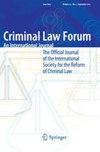“Tool in the R2P Toolbox”? Analysing the Role of the International Criminal Court in the Three Pillars of the Responsibility to Protect
IF 0.8
Q3 CRIMINOLOGY & PENOLOGY
引用次数: 4
Abstract
In the last two decades, two important instruments emerged to combat mass atrocities. In 2002 the International Criminal Court (ICC) was established. Subsequently, in 2005, the international community politically committed itself to the responsibility to protect populations from mass atrocities (R2P) distinguishing three pillars: (i) the responsibility of the state to protect its own population, (ii) the responsibility to help states live up to this responsibility and (iii) the responsibility of the international community to intervene when states manifestly fail to protect their population. While the ICC is frequently referred to as a “tool in the R2P toolbox,” an analysis of the ways in which the ICC works within R2P’s pillar structure was missing. Using the R2P pillar-structure, this article systematically analyses how the ICC plays a role in the implementation of R2P. More specifically, this paper disentangles the diverse modalities of ICC engagement with states – such as ratification of its Statute, positive complementarity, opening of preliminary examinations or investigations – and demonstrates the complex dynamics of the interaction between the implementation of R2P and the actions of the ICC. The workings of the Court create fluid dynamics that shift back and forth between the different pillars at different points in time. In addition, the ICC can contribute to different pillars at the same time. In some instances, however, it fits uncomfortably in the R2P pillar structure, necessitating the conceptualisation of a pillar two and a half.“R2P工具箱中的工具”?分析国际刑事法院在保护责任三大支柱中的作用
在过去二十年中,出现了两个打击大规模暴行的重要工具。2002年,国际刑事法院(ICC)成立。随后,在2005年,国际社会在政治上承诺有责任保护人民免受大规模暴行(R2P),并区分了三个支柱:(i)国家有责任保护自己的人民;(ii)有责任帮助各国履行这一责任;(iii)当国家明显未能保护其人民时,国际社会有责任进行干预。虽然国际刑事法院经常被称为“R2P工具箱中的工具”,但对国际刑事法院在R2P支柱结构中的工作方式的分析却缺失。本文运用R2P支柱结构,系统分析了国际刑事法院在R2P实施中的作用。更具体地说,本文阐述了国际刑事法院与各国接触的不同模式——如批准其《规约》、积极互补、开展初步审查或调查——并展示了实施R2P与国际刑事法院行动之间复杂的互动动态。法院的工作创造了流体动力学,在不同的时间点在不同的支柱之间来回移动。此外,国际刑事法院可以同时为不同的支柱作出贡献。然而,在某些情况下,它不适合于R2P支柱结构,因此有必要概念化两个半支柱。
本文章由计算机程序翻译,如有差异,请以英文原文为准。
求助全文
约1分钟内获得全文
求助全文
来源期刊

Criminal Law Forum
Multiple-
CiteScore
1.00
自引率
0.00%
发文量
17
期刊介绍:
Criminal Law Forum is a peer-review journal dedicated to the advancement of criminal law theory, practice, and reform throughout the world. Under the direction of an international editorial board, Criminal Law Forum serves the global community of criminal law scholars and practitioners through the publication of original contributions and the dissemination of noteworthy public documents. Criminal Law Forum is published pursuant to an agreement with the Society for the Reform of Criminal Law, based in Vancouver, British Columbia.
 求助内容:
求助内容: 应助结果提醒方式:
应助结果提醒方式:


